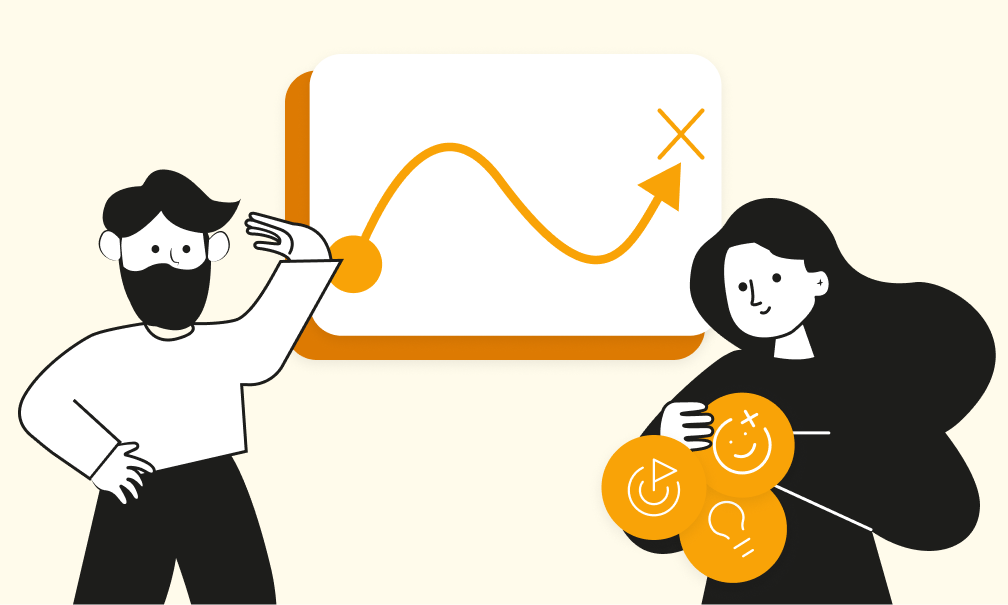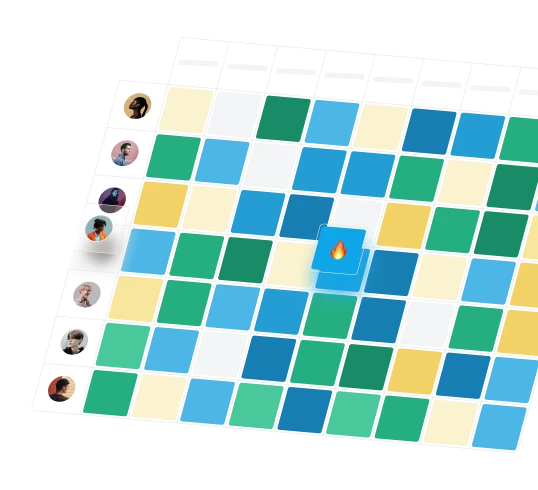
How to Improve Employee Experience: Enhanced Productivity!


- What Is Employee Experience?
- Improving Employee Experience: The Path to Organizational Success!
- Why Does An Employee Experience Solution Matter?
- To Sum Up
Employees are the heart of every organization, and without them, you can’t survive in the business world.
The employee experience (or EX) encompasses every work interaction an employee encounters from the moment they apply for a job to the moment they leave their company.
According to a study by Gallup, companies with highly engaged employees outperform their peers by 147% in earnings per share.
Furthermore, a report by the Harvard Business Review found that organizations that prioritize employee experience are 4.2 times more profitable than those with weaker career opportunities.
Recently, leaders have also begun to notice just how much the employee experience can affect productivity and profitability. But why and how to improve employee experience?
In this article, we will explore what employee experience is and what the possible approaches to improving employee experience are.
Bear with us to understand the solution to employee experience!
Our organizational culture platform enhances employee experience and upgrades organizational growth via personal development.
What Is Employee Experience?

Employee experience is basically the overall events an individual experiences during the time they work for an organization.
This period of time includes when they are hired up to when they leave the company.
Employee experience has always been a determinant of organizational success and development.
However, since the Great Resignation of 2021, with around 4 million Americans quitting their jobs, this matter has become more noticeable.
Business owners have now realized that employee experience (EX) has a direct impact on their customer experience (CX) and overall success.
But what drives workforce satisfaction, and where can we start improving employee experience? Our employee experience solution guide is here to lead you toward a more productive path!
Improving Employee Experience: The Path to Organizational Success!

There are various factors affecting an employee's life and experience in your organization.
However, we will further discuss a few advantageous items that both management and employees can benefit from:
1. Map out the Employee Life Cycle in your organization.
As we mentioned earlier, employee experience includes the entire period an individual is in touch with your organization!
The employee life cycle or the employee journey has three main segments:
- 🔍 Pre-Employment: This section encompasses several steps, including searching for the job, being attracted to your organization, applying for a position, interviewing, and recruiting.
- 💼 Employment: This usually constitutes most of the employee journey. The employment time starts with onboarding and includes all the time an employee works in your organization.
- 🌴 Post-Employment: Even though this might sound irrelevant, leaving employees also has an impact on your overall success.
By conducting detailed journey mapping sessions with different departments, you can identify touchpoints and pain points in each stage and effectively improve the work environment for your workforce's well-being.
2. Prioritize people over processes!
Your team members are the ones who drive success!
Prioritizing the employees over processes has always been one of the characteristics of great leaders.
By applying a dynamic feedback system and employee survey systems, you can visualize what your team requires the most and start prioritizing to improve your employee experience.
A people-centric approach that prioritizes people over processes reportedly results in fostering growth, building trust, enhancing engagement, and improving overall organizational success.
- Case Study: Atlassian
As Atlassian, a renowned software company, grew rapidly, it had to face unprecedented challenges to maintain employee engagement and improve employee experience.
Atlassian decided to alter the rigid and traditional processes and prioritize workforce well-being.
With that in mind, Atlassian implemented several strategies, such as a dynamic feedback system, flexible work arrangements, employee retention programs, and investment in personal development.
This shift has yielded remarkable results for Atlassian.
3. Ensure management involvement.
Management involvement is one of the most effective approaches to improving employee experience.
By actively participating in regular communication, managers can have a holistic view of their team.
Implementing feedback systems, such as an employee performance review software, allows management to make informed decisions that align with employee expectations.
- Case Study: Salesforce
The Ohana community (Ohana means family in Hawaiian) is an interactive group that includes both inside and outside people related to Salesforce.
Salesforce describes Ohana as: “a deep-seated support group we nurture inside our company.
And it doesn’t stop at our employees — it extends to our partners, customers, and members of the communities that we call home.
We collaborate, take care of one another, have fun together, and work to leave the world a better place.
4. Recognize and value your team with visual appreciation.
By showing your employees that they are valued and rewarded for their work in your organization, you give them a sense of purpose.
Reportedly, employees who feel they have a meaningful job tend to be more engaged and satisfied.
You can create an appreciation platform for a dynamic, rewarding system between employees and managers to enhance morale and productivity.
This digital platform can also be beneficial for remote workers who aren’t able to enjoy the physical environment of your company.
- Case Study: Google
Google’s “gThanks” platform enables peers to recognize each other’s work and boosts productivity and appreciation within the organization.
Lazlo Bock, former SVP of People at Google, stated: “Simple, public recognition is one of the most effective and most underutilized management tools.”
The Kudo Wall is a specifically designed platform to visualize praise within your organization to improve employee experience and productivity.
5. Encourage transparency and open communication.

Communication between colleagues, employees, managers, etc., has always been an under prioritized area in some organizations.
A healthy work culture promotes open communication as an approach to improving employee experience.
However, sometimes employees don’t have a sense of job security, or they haven’t been encouraged to express their sentiments candidly.
Hence, they withdraw from speaking the truth or bail on surveys and feedback sessions.
Organizations need to build a transparent and trustworthy environment so that employees feel safe about giving feedback and expressing ideas to improve the employee experience.
6. Create Flexible Working Arrangements.
This factor is basically the alphabet of the employee experience solution!
Creating flexible work hours, offering a well-adjusted work-life balance, and accommodating various working styles are some of the adjustments you can make to enhance employee experience easily.
Reportedly, individuals are, now more than ever, inclined towards organizations that provide a positive employee experience.
7. Foster a healthy and enjoyable work environment.
An enjoyable workplace is more than an idea. By offering various amenities and healthy activities within your organization, your employees will have a more positive experience in their work environment, which will result in higher engagement and productivity.
You can implement various amenities and activities within and outside your organization, such as on-site fitness centers, gym membership reimbursements, mental health consultants, etc., to encourage a healthy lifestyle among your workforce.
Moreover, the physical work environment is also of great significance.
Office layout, break rooms, and ergonomic aspects highly affect your team’s mood and performance.
- Case Study: Google
As a well-known organization in employee experience, Google has provided its employees with on-site gyms, yoga centers, and healthy food to boost physical and mental health support for optimal organizational success.
8. Invest in professional development for organizational growth.
Development opportunities and career growth options are one of the key factors in improving employee experience.
One essential factor in professional development is allocating the proper resources.
Once you know what your employees need, you must provide them with adequate assets so they can perform well in their positions.
You can start by identifying the skill sets and skill gaps within your organization by using a skills gap assessment tool to cover every area in your organization for further strategies.
Employees who feel a sense of thriving in their careers are more likely to be engaged and productive.
Our Skills Management platform allows you to collect and organize your team’s skills and identify skill gaps to plan for professional development and career growth.
9. Encourage collaboration, teamwork, and inclusion.
An inclusive culture, in addition to respectful teamwork and collaboration, enhances your work environment.
Moreover, nurturing a respectful and inclusive environment can also make the remote workers feel included and increase employee experience.
You can promote teamwork and inclusion via group activities, diversity programs, and visual praise platforms such as The Kudo Wall.
10. Monitor your progress.
After implementing such changes, the most significant step is tracking your changes.
You can use employee survey systems, focus groups, interviews, etc., to monitor how your employees feel about the changes in their work environment.
By continuously tracking your progress and checking your team’s feedback, you can foster a better and more productive work environment, as well as improve employee experience.
Why Does An Employee Experience Solution Matter?

Basically, employee experience is the product you are offering your team.
In other words, you are waging your Customer Experience when it comes to your team’s satisfaction.
Because your employees experience your organization, and simultaneously, they are the main operative tool in creating your product.
So, not only are your team members the customers of your organizational environment, but they also hugely affect your primary customer experience with their work quality.
It’s evident that by improving employee experience, you also have upgraded your overall work quality, employee engagement, and productivity.
Jody Kohner, Senior Vice President at Salesforce, once stated: “Culture and employee experience have become a business imperative.
For a company that’s growing as rapidly as we are, our culture makes a huge difference in our ability to attract and retain talent.”
To Sum Up
In this article, we illustrated the tangible methods of adopting a people-first approach and improving the employee experience.
These approaches will not only boost morale but also drive productivity and retention, proving that a focus on employee recognition can have substantial benefits for both employees and the entire organization.
Creating a healthy and enjoyable work environment involves addressing physical, mental, and social well-being.
By promoting health, supporting work-life balance, investing in professional development, and recognizing achievements, companies can improve employee experience and productivity.
These efforts not only enhance employee engagement but also upgrade overall organizational performance.
By submitting this form, I confirm that I have read the privacy policy and that I consent to the processing of my personal data by agyleOS for the purposes stated. In the event of consent, I can revoke my consent at any time. Furthermore, by submitting the form, I agree to the general terms and conditions.


- Product
- Resources
- Compare
- Company
